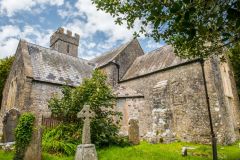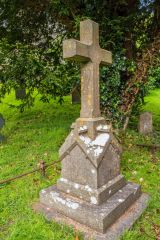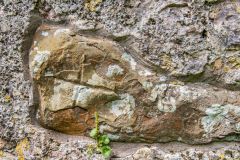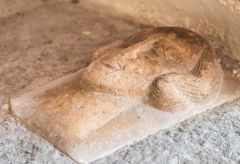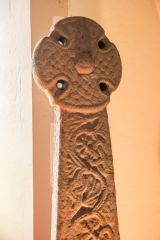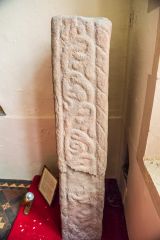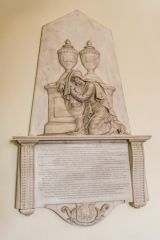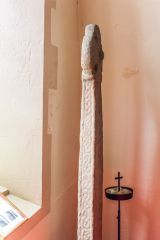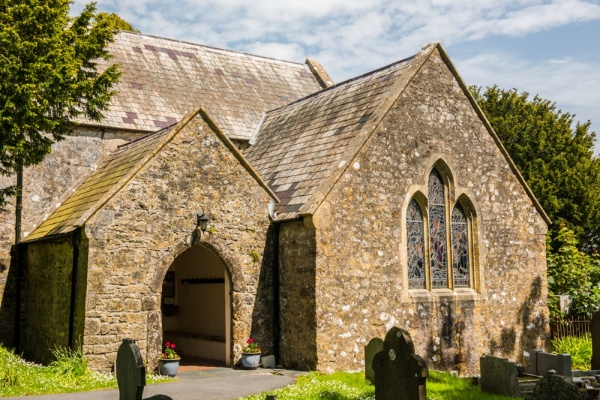
The historic church of Penally is dedicated to St Nicholas & St Teilo. St Nicholas is the patron saint of seafarers, which seems appropriate given the church's proximity to the sea. Unlike St Nicholas, St Teilo is not so well-known outside Wales. Teilo was a 6th-century missionary, thought to be a cousin of St David and a grandson of Ceredig, the ruler of Ceredigion. Perhaps just as importantly, he was born in Penally.
We do not know when the first church was established in Penally but it may have been during Teilo's lifetime or shortly after. We do know that Penally was a stopover place for pilgrims travelling from Brittany and Cornwall to Ireland. Rather than make the long sea journey around the westernmost point of Wales, pilgrims would land at Penally and make the journey on foot to Cardigan Bay where they could take ship again to cross the Irish Sea.
The Celtic church was replaced by the present building, probably in the 13th century, and a porch was added in the following century. The base of the tower is probably 15th century, with the top section built in the Tudor period.
During restoration work in the 1850s, a series of medieval wall paintings were discovered near the chancel arch. Decoration included Biblical figures, stencilled stars, and inscriptions. Unfortunately, the paintings were promptly covered up again by the Victorian restorers. The restoration also swept away a medieval painted screen.
Though the Victorians destroyed much of historical interest, they did make Penally the first church in Wales to be lit by electricity in 1891. They also installed colourful stained glass windows.
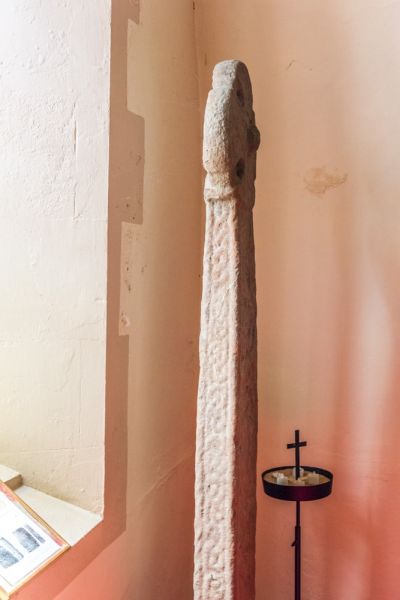
The Penally Cross
The pride of Penally church is a pair of ancient Celtic crosses in the south transept, thought to date to the 10th century. The crosses stood outside for over 1000 years but were moved inside the church for preservation in the 20th century.
The most interesting is the Penally Cross, a beautifully carved wheel-head cross with ornate carvings on both faces. The cross is decorated with intricate knotwork and scroll designs, with interwoven vines and grape clusters. The sides feature a continuous band of twists and knotwork. The cross probably dates to the first half of the 19th century. The stone base that originally supported the cross still stands outside the west end of the church.
The other cross is more fragmentary, but it bears a beautiful carving of 'gripping beasts'; a pair of grotesque beasts with forelegs and tails interlaced. Each beast has a small animal in its mouth, and each animal devours an end of a vine tendril. This cross interests historians because it combines Celtic, Scandinavian, and Anglo-Saxon art. It also dates to the early 10th century.
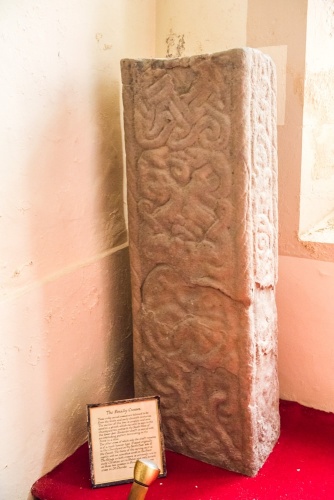
There was originally a third cross, a beautifully carved fragment of a cross base with knotwork decoration and a Latin inscription commemorating Maile Domnac. Unfortunately, the cross fragment has been lost, but there is a plaster cast in the National Museum of Wales in Cardiff.
Also in the south transept is a 13th-century altar tomb set into a low niche in the wall. The tomb probably dates to the period 1260-1290. The inscription is very worn and has been interpreted in various ways by historians over the centuries. It may refer to a William de Raynor and his wife Isemay, though William's name has been variously interpreted as Hamto, Haunton, and Naunton. On top of the tomb are carved faces of a man and woman flanking an elongated Calvary Cross.
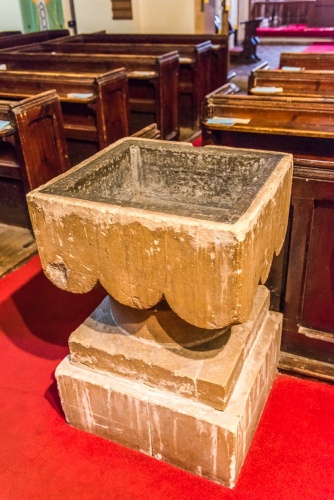
Other interesting features inside the church include a Norman font, re-dressed in the 19th century. The font is carved with traditional Norman scallop shapes on each side and is supported by a round column atop a small, square base.
There are several interesting 18th and 19th-century memorials including a very finely sculpted tablet to Lawrence Cook, who died in 1792.
Set into the north-eastern exterior wall of the north transept is another carved stone; a simple Latin cross without an inscription. The cross may date to the 8th century but is probably not older than the 5th century. It may have marked the traditional pilgrim route to St David's.
Opposite the west door of the church is the burial place of several children of the famous Victorian watercolourist Charles Norris. Norris was also a passionate architectural historian and did much to record Tenby's Tudor architecture before the town was dramatically altered as a seaside resort in Georgian style.
St Nicholas and St Teiilo is a wonderful church, full of historic interest. The two Celtic crosses alone are well worth a trip to see. The church was open when we visited and as far as we can determine is regularly open to visitors. There did not appear to be any dedicated parking area near the church but we had no trouble finding space along the road near the wear memorial.
About Penally, St Nicholas & St Teilo Church
Address: Penally Village Road,
Penally,
Pembrokeshire,
Wales, SA70 7PN
Attraction Type: Historic Church
Location: On Penally Village Road, just off the A4139
Website: Penally, St Nicholas & St Teilo Church
Location
map
OS: SS117991
Photo Credit: David Ross and Britain Express
HERITAGE
 We've 'tagged' this attraction information to help you find related historic attractions and learn more about major time periods mentioned.
We've 'tagged' this attraction information to help you find related historic attractions and learn more about major time periods mentioned.
Find other attractions tagged with:
NEARBY HISTORIC ATTRACTIONS
Heritage Rated from 1- 5 (low to exceptional) on historic interest
Tenby Medieval Town Walls - 1.3 miles (Historic Building) ![]()
Tenby, St Mary's Church - 1.3 miles (Historic Church) ![]()
Tenby Castle - 1.3 miles (Castle) ![]()
Tudor Merchant's House - 1.4 miles (Historic House) ![]()
Tenby Museum & Art Gallery - 1.5 miles (Museum) ![]()
Carswell Medieval House - 1.7 miles (Historic Building) ![]()
Caldey Island Priory - 2.1 miles (Abbey) ![]()
Caldey Island, St David's Church - 2.2 miles (Historic Church) ![]()
Nearest Holiday Cottages to Penally, St Nicholas & St Teilo Church:
More self catering near Penally, St Nicholas & St Teilo Church
